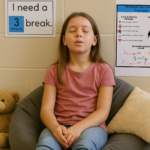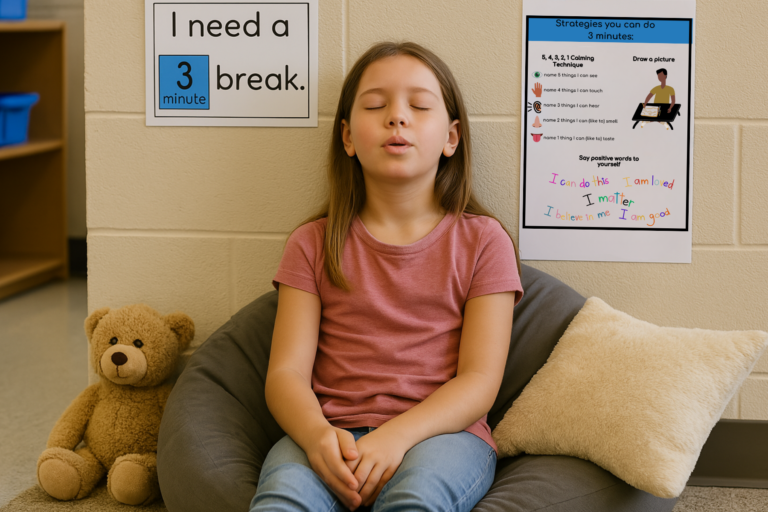

You’ve probably seen it before — a student shuts down mid-task, a child storms off after a redirection, or your own kid crumples into a puddle of frustration. We often treat these moments as behavior problems, but what if they’re really communication?
What if what that child needs… is a break?
But not just any break. Not the kind that feels like giving up or walking away from responsibility. I’m talking about a regulated, intentional pause — one that helps a child reset and return, not escape and avoid.
In this post, we’ll reframe breaks as a proactive skill — one that supports focus, emotional regulation, and resilience. You’ll learn what makes a break effective, how to teach it like any other routine, and the I Need A Break tool I’ve created to make it easier for everyone involved.
Too often, breaks are introduced reactively — after a child has already melted down or shut down. But what if we taught kids to notice when they’re becoming overwhelmed — and gave them a structured tool to manage it?
Taking a break is a skill, just like lining up for recess, turning in homework, or asking for help. It needs:
A clear purpose (why we take breaks)
A simple process (how to take a break)
Repeated practice and feedback (how we get better at it)
When taught proactively, breaks help kids stop, regulate, and refocus — not escape responsibility. And when kids learn how to use that tool, they don’t just behave better… they feel better.
A well-timed break gives a child the chance to do something their brain and body can’t do in the middle of dysregulation: reset.
Whether it’s anxiety, sensory overload, frustration, or fatigue, behavior often follows internal distress. A proactive break helps a child:
Recognize what they’re feeling
Use a strategy that calms them
Rejoin the task with a fresh mindset
This kind of self-awareness and recovery isn’t automatic — it’s taught.
Telling a child to “go calm down” isn’t a break — it’s isolation. And it doesn’t teach the child how to calm down, or when they’re ready to return.
A meaningful break is:
Clearly defined — a chair, corner, or designated area that’s distinct from work space
Supported by visuals or choices — calming strategies the child can pick from
Framed with intentional language — “Take a break so you can feel better, then come back and try again”
Part of the plan — not a punishment, not a free-for-all, but a routine
When breaks are consistent, kids know what to expect — and what’s expected of them.
You wouldn’t expect a child to instinctively know how to line up, make their bed, or turn in homework. Breaks are no different — they need to be introduced, modeled, and practiced just like any other part of your day.
Here’s a simple teaching sequence:
Introduce the concept during a neutral moment
“Sometimes our brains feel too full. A break can help us feel better so we can keep going.”
Model what a break looks like — narrate your own calm-down moments or use a puppet or roleplay
“I’m feeling a little tense. I’m going to sit quietly for a few breaths, then come back.”
Offer visual support that guides the process
Use a simple visual that shows how to request a break, what to do during it, and when to return.
Practice and reinforce the routine
Offer praise, reminders, and chances to try again — just like you would with lining up or transitioning between activities.
If you’re looking for a simple, ready-to-use support to help kids learn how to take effective breaks, I created the “I Need a Break” visual support for exactly that reason.
It’s:
Printable and editable
Kid-friendly and classroom-tested
Designed to help kids ask for a break, choose a calming strategy, and know when to return
You can post it in a calm-down area, keep it in a folder, or laminate it for home or classroom use.
🎯I Need a Break
Check it out here — and give your kids a routine that builds real resilience.I
You don’t need to wait for a behavior blow-up to teach break-taking. When it’s embedded into your routines and taught like any other skill, it becomes one of the most powerful tools a child can learn — for the classroom, for home, and for life.

The Behavior Bestie